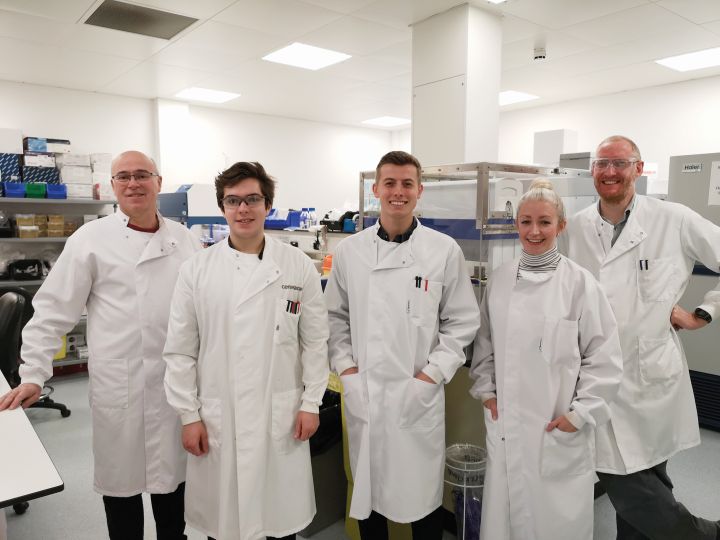Tecan uses cookies to improve our website. By continuing to browse our website, you accept our cookie policy.
Tecan uses cookies to improve our website. By continuing to browse our website, you accept our cookie policy.

CNS disorders are often seen as the greatest area of unmet medical need, and are characterized by changes or degeneration in specific subsets of neurons and other cell types in the brain. Pharmaceutical start-up Cerevance is using a new sequencing method to study specific cell types from post-mortem brain tissue, helping the company to understand the pathology of these conditions in more detail than previously possible.
Cerevance was established in 2016 as an independent spin-out of global pharmaceutical company Takeda. The company is headquartered in Boston, US, but R&D takes place at its UK facility on the Cambridge Science Park, and is focused on neurological conditions such as Alzheimer’s, Parkinson’s, Huntington’s and some psychiatric disorders. Steve Sheardown, Head of Molecular Biology and Cell Engineering at Cerevance, explained: “A huge proportion of people end up suffering from CNS diseases, and there are limited therapies on the market that address the majority of them.”
“We use a novel technology – Nuclear Enriched Transcript Sort Sequencing (NETSseq™), developed in the Rockefeller Institute – to sequence individual neuronal cell types from post-mortem human brain samples, so that we can understand their role in different disorders. This method enables us to work with thousands of isolated nuclei at a time, providing a deep sequence that is a much higher resolution than single cell or single nucleus sequencing, and allowing detailed transcriptomic profiling of defined cell populations. We can use this data to identify functionally significant changes to neuronal or glial cells during a particular disease process, and to assess the potential of new therapeutic targets. We receive samples from brain banks across the US, UK and Europe, and this network has allowed us to build an extensive collection of tissue samples, covering all stages of different diseases, as well as unaffected controls, generating well-defined patient cohorts. We can identify critical differences between the neuronal circuits of affected and unaffected groups to build hypotheses around what could be modulated to affect the progression of a disease, before moving on to drug discovery.”

The Molecular Biology and Cell Engineering team (left to right): Steve Sheardown, Daniel Barker, Samuel Russell, Clare Bender and Jason Lawrence
“We wanted to automate our workflow and convert it into a high throughput platform because, although the NETSseq method was effective when first implemented, we were conducting everything manually. Our throughput needed scaling up to be able to process larger numbers of samples to grow our database. The challenge is that the quality of post-mortem tissue can vary substantially between samples, and you can be working with highly degraded material, so we needed a solution that could cope with that.” The recent acquisition of NuGEN by Tecan has brought a wealth of expertise in NGS reagents and innovative products to the Tecan family, and it was this expertise that led Cerevance to choose a Tecan solution. Steve added: “We evaluated all of the kits available from different manufacturers for extracting RNA and producing sequencing libraries, and trialed several different kits against each other before deciding on the Trio RNA-Seq library preparation kit from Tecan. It gave us the most consistent results from the lowest amount of material, even using very degraded samples. The built-in DNA removal step at the beginning is very effective, which is important because nuclei have a very high DNA to RNA ratio. The kit saves us from doing this step separately, which streamlines our workflow. It was also automation friendly and could easily be adapted to our current robot, so it met all of our needs.”
"It gave us the most consistent results, from the lowest amount of material, even using very degraded samples."
“Tecan sent one of its technical specialists to us for a week to help us set up the automated workflow. This was useful, because it’s quite complex to go from tubes on a bench to plates on a robot, especially as our workflow has multiple steps from RNA preparation to individual sample dilution. Working closely with them helped us to optimize all of the small details, like reagent supply or tube fill volumes, and the platform is now running beautifully. It effortlessly copes with our current throughput – determined by the amount of brain material that can be processed and supplied to us – and is scalable so that we could easily cope with more, giving plenty of room for growth. The new set-up saves us a lot of time, while improving the consistency and reproducibility of our workflow. Automation makes sample errors a thing of the past, and eliminates the possibility of a human transposing a row or making an error, which would lead to interpreting the wrong sequences for the wrong samples. Every tube and plate is barcoded and tracked by the robot, so we never lose a sample and can easily pull up its data on a spreadsheet.”
“We’re now trialing the higher sensitivity Ovation® SoLo™ RNA-Seq System from Tecan, which will be beneficial for analyzing samples that are extremely degraded, or for looking at rare cells which are only present in low numbers. We’re also discussing other methods that we are interested in incorporating into our research, such as automated single nucleus sequencing. The relationship we have with the Tecan team is excellent; they are very easy to work with and have completely understood our needs from the beginning. I’m excited for the future,” concluded Steve.
To find out more about Tecan’s RNA-Seq solutions, visit www.nugen.com/products/rna-seq
To learn more about the work Cerevance does, go to www.cerevance.com